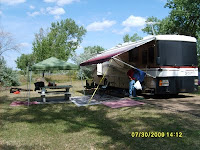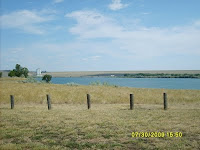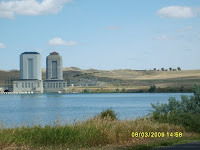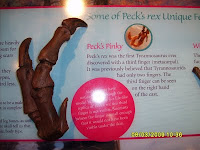OK- we are up to date and it looks like the rain is stopping and dawn is breaking. I might see if I can get in an hour or so of sleep before breakfast, although I will make the coffee now so Bruce just has to push the button when he gets up. See you later!
The travels and travails of 2 retirees as they explore the US and Canada with Hazel the superdog. This blog is for our family and friends (even new ones that stumble on this narrative) who want to follow along with us on our journeys.
Wednesday, July 29, 2009
Fort Peck Dam and surrounding area
It is early Tuesday morning, August 4th and I am again late with this posting. We arrived at the Downstream Campground at Fort Peck Dam and Lake around 2 on Wednesday. We were fortunate that there were several walk-in sites available for the 4 nights we would need until our regular reservation kicked in. We had traversed US 2 east from Havre, Mt to Glasgow. MT. where we turned south on MT 24 towards Ft. Peck and then NE on MT 117 to the dam and campground. The road wound through the Montana farming areas where right now it appears hard ed spring wheat and the resulting hay once it is harvested seemed to be the biggest crops we saw and cows, horses and sheep the livestock of choice. We drove along the Milk River, following the Lewis & Clark trail. Isn't it amazing that so many of our cross county principle roads and interstates follow the old trails from east to west? Driving them and seeing all of the historical markers memorializing all the pioneers went through and their accomplishments is an eye opener. We did not plan this trip around those major pieces of history, so having all of this coincide has been a real treat. Today, even Bruce said that is was really amazing what you miss when you fly in a plane from one place to another, knowing nothing of what it took to get there in the past and never really seeing what this country may have looked like to those travelers or appreciating what it looks like today. As I may have have said before, the destination is nice, but the road traveled is the real enjoyment for us.
 Downstream Campground is beautiful, even if you have to fill your water tanks instead of having water at your site. That is no big deal for us, we knew it ahead of time and came full and if we use it all then the closest water faucet is just across the road. The sites are well spaced, many are shaded and most offer all the privacy you would need or want. The Missouri River is just outside the park along with Ft. Peck Dam and also the Ft. Peck Interpretive Center where you can learn about the construction history of the dam, the C. M. Russell National Wildlife Refuge and paleontology, including a cast of the Tyrannosaurus Rex known as Peck’s rex. So, since Tuesday we have been enjoying the campground, doing some sight seeing of the dam and surrounding area and I found a wonderful Quilt Store where I went crazy Friday & Saturday. This store, Plaid Square, was having a great sale as part of Glasgow's Crazy Days celebration and I found so many things at 40 and 50% off that I went crazy for 2 days. Many of their kits were in the sale, so I had to buy a few and she had quite a selection of sale fabric for $3 yard. What a find!
Downstream Campground is beautiful, even if you have to fill your water tanks instead of having water at your site. That is no big deal for us, we knew it ahead of time and came full and if we use it all then the closest water faucet is just across the road. The sites are well spaced, many are shaded and most offer all the privacy you would need or want. The Missouri River is just outside the park along with Ft. Peck Dam and also the Ft. Peck Interpretive Center where you can learn about the construction history of the dam, the C. M. Russell National Wildlife Refuge and paleontology, including a cast of the Tyrannosaurus Rex known as Peck’s rex. So, since Tuesday we have been enjoying the campground, doing some sight seeing of the dam and surrounding area and I found a wonderful Quilt Store where I went crazy Friday & Saturday. This store, Plaid Square, was having a great sale as part of Glasgow's Crazy Days celebration and I found so many things at 40 and 50% off that I went crazy for 2 days. Many of their kits were in the sale, so I had to buy a few and she had quite a selection of sale fabric for $3 yard. What a find!
 Yesterday we actually toured the Ft. Peck Hydroelectric Plant that is part of the dam. This dam is one of the few in the country where you can get close to anything since 9/11 so we took advantage and spent time learning about the construction and the history surrounding it. We got to go down into the plant, see the generators, learned about the flood gates, etc. The tour isn't real long, but it is definitely worth doing. Ft. Peck Dam is the largest hydraulically earth filled dam in the world. Electrically operated dredge boats dredged Missouri River bottom sands, silts and clays which were then pumped through 28” pipelines to the dam site to build this dam.
Yesterday we actually toured the Ft. Peck Hydroelectric Plant that is part of the dam. This dam is one of the few in the country where you can get close to anything since 9/11 so we took advantage and spent time learning about the construction and the history surrounding it. We got to go down into the plant, see the generators, learned about the flood gates, etc. The tour isn't real long, but it is definitely worth doing. Ft. Peck Dam is the largest hydraulically earth filled dam in the world. Electrically operated dredge boats dredged Missouri River bottom sands, silts and clays which were then pumped through 28” pipelines to the dam site to build this dam. 
 The picture above shows one of the generator units with it's surge tower and the dam stretching to the right across the whole horizon. The dam is 4 miles across, 250 feet tall and 1/4 mile wide at the base. The water diversion and control valve gates are 1/4 mile away from the power plant as you can see in the photo on the left. They are the small towers in the top right of the picture. The spillway is another 1/4 mile away and has only been used 3 times since it was completed and the the last time it was opened was 20 years ago. Even then, only 3 of the gates were used. It has been called the largest bowling alley in the world and its construction was the cover picture of the very first Life Magazine published November 23, 1936. That picture is copyrighted but you can find it by typing into Google search "Fort Peck Dam Life Picture". The dam was constructed during the depression, authorized by Roosevelt in 1933 and begun 9 days later. Over 40,000 people showed up in the area to support this endeavor and at its heyday almost 11,000 people were employed related to the dam's construction. There was an major accident in 1938 when 1/3 of the almost completed dam gave way, killing 8 men in the slide, but although the independent review committee said there was risk in continuing, they did recommend completion. The dam and spillway were completed in 1930 and began generating electricity in 1943.
The picture above shows one of the generator units with it's surge tower and the dam stretching to the right across the whole horizon. The dam is 4 miles across, 250 feet tall and 1/4 mile wide at the base. The water diversion and control valve gates are 1/4 mile away from the power plant as you can see in the photo on the left. They are the small towers in the top right of the picture. The spillway is another 1/4 mile away and has only been used 3 times since it was completed and the the last time it was opened was 20 years ago. Even then, only 3 of the gates were used. It has been called the largest bowling alley in the world and its construction was the cover picture of the very first Life Magazine published November 23, 1936. That picture is copyrighted but you can find it by typing into Google search "Fort Peck Dam Life Picture". The dam was constructed during the depression, authorized by Roosevelt in 1933 and begun 9 days later. Over 40,000 people showed up in the area to support this endeavor and at its heyday almost 11,000 people were employed related to the dam's construction. There was an major accident in 1938 when 1/3 of the almost completed dam gave way, killing 8 men in the slide, but although the independent review committee said there was risk in continuing, they did recommend completion. The dam and spillway were completed in 1930 and began generating electricity in 1943.
 The other notable thing about this area is that the Fort Peck Lake area is full of fossils. The only skeleton of an akylosaurus was found in that area and the the most complete skeleton of a T-Rex was found 20 miles from the Interpretive Center in 1997. That T-Rex fossil is now called Peck's rex. The T-Rex original bones are too heavy and fragile for a display so they are stored at the Paleontology Field Station at Ft. Peck although the replica in the Interpretive Center was cast from the original fossil. .
The other notable thing about this area is that the Fort Peck Lake area is full of fossils. The only skeleton of an akylosaurus was found in that area and the the most complete skeleton of a T-Rex was found 20 miles from the Interpretive Center in 1997. That T-Rex fossil is now called Peck's rex. The T-Rex original bones are too heavy and fragile for a display so they are stored at the Paleontology Field Station at Ft. Peck although the replica in the Interpretive Center was cast from the original fossil. . Additionally, the center has the massive skull of a triceratops on display. All of the displays are wonderful and should you ever be in the area- go and see them. And here are 2 small bits of information I bet you did not know - no T-Rex has ever been found on any continent but North America and the Tyrannosaurus has a third finger which scientists had previously not known until Peck's rex was discovered.
Additionally, the center has the massive skull of a triceratops on display. All of the displays are wonderful and should you ever be in the area- go and see them. And here are 2 small bits of information I bet you did not know - no T-Rex has ever been found on any continent but North America and the Tyrannosaurus has a third finger which scientists had previously not known until Peck's rex was discovered.
OK- we are up to date and it looks like the rain is stopping and dawn is breaking. I might see if I can get in an hour or so of sleep before breakfast, although I will make the coffee now so Bruce just has to push the button when he gets up. See you later!
OK- we are up to date and it looks like the rain is stopping and dawn is breaking. I might see if I can get in an hour or so of sleep before breakfast, although I will make the coffee now so Bruce just has to push the button when he gets up. See you later!
Subscribe to:
Comments (Atom)